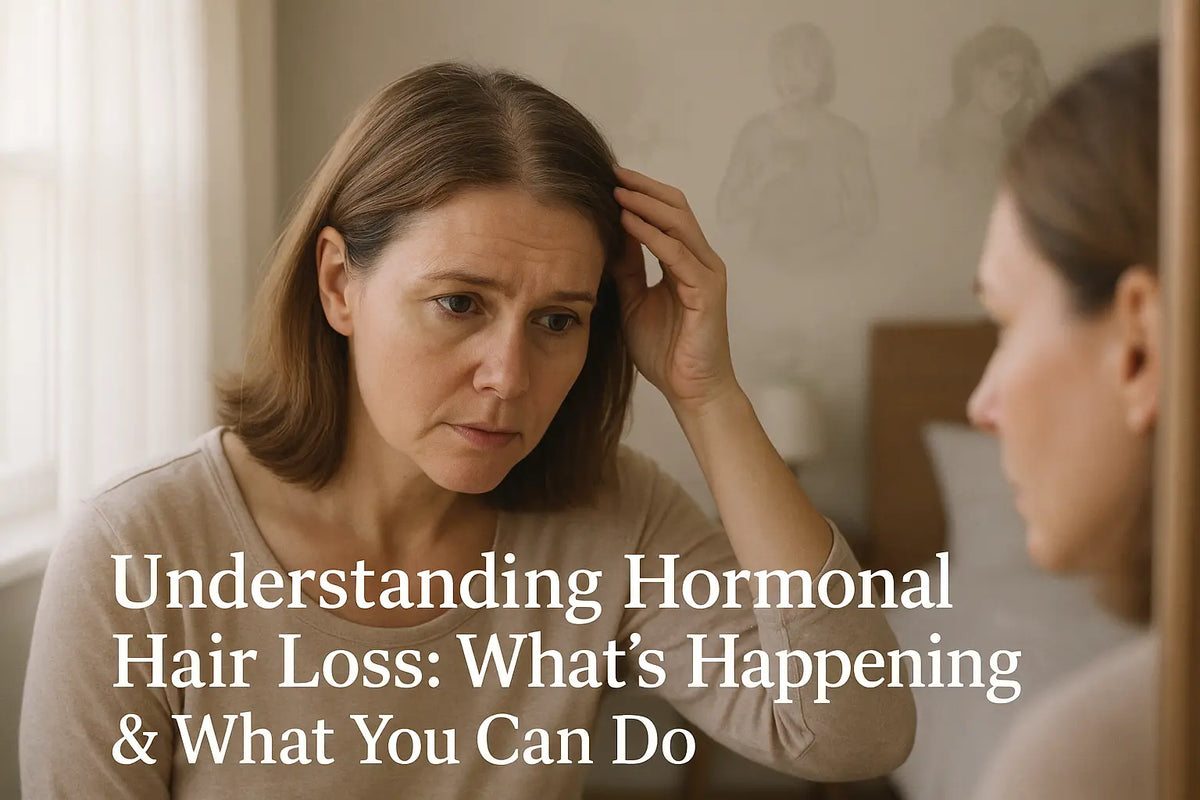In this article
Hair loss can hit hard and feel overwhelming.
Stress, aging, habits, and genetics all play a role. But many overlook a key trigger: shifting hormones. Hormone fluctuations often lead to thinning. So what causes hormone-related hair loss—and can you treat it?
Keyoma breaks it down, showing you the root cause and how to fight back.
If hormones drive your shedding, our targeted solutions can rebuild volume and restore your confidence.
What Is Hormonal Hair Loss?
Hormonal hair loss happens when shifts in your hormone levels trigger visible thinning or increased shedding.
Your hormones control key body processes—metabolism, mood, and yes, hair growth.
Hair follicles sit in your skin and anchor each strand. Androgens, a class of hormones, directly affect how these follicles function.
When androgen levels go off balance, they shrink follicles, shorten hair growth cycles, and lead to breakage or fallout.
Several health issues tied to hormone disruption often result in hair loss. These include:
Each condition stems from different triggers and shows unique signs.
You need to identify the specific type of hormone-related hair loss to choose the right treatment.
How Hormones Affect the Body and Hair
Most people link hormones to major life stages like puberty, pregnancy, or menopause. But your endocrine system does more than drive change—it helps maintain balance.
Hormones control many parts of your health, such as your:
-
Metabolism
-
Fertility and sex drive
-
Sleep cycles
-
Blood pressure
-
Physical growth
-
Emotional state
Conditions like diabetes, PCOS, and thyroid dysfunction often disrupt hormone levels.
These imbalances can trigger a wide range of problems—low energy, poor sleep, weak bones, or insulin issues. Hair thinning, especially androgenic alopecia, is another frequent result.
Hormones and Hair Growth Cycles
Several triggers can throw off your hormone balance and lead to hair loss—age, genetics, hormone shifts, and underlying health issues. Stress, medication, and daily habits can also make the shedding worse.
This section breaks down the most common causes of hormone-driven hair loss.
How Pregnancy Hormones Affect Hair

Pregnancy and postpartum often shift hormone levels in ways that affect your hair. Some women notice fuller, glossier strands while pregnant thanks to higher estrogen. But after birth, many deal with shedding or changes in hair texture as hormones drop.
Hair Loss Before Birth
During pregnancy, estrogen levels rise sharply. This hormone slows the natural shedding process, so hair stays in place longer.
That’s why some women notice fuller, denser hair while expecting. But not everyone gets that result. Many pregnant women see more hair fall instead, a condition known as telogen effluvium.
Several things can cause this unexpected shedding:
-
Nutrient gaps. Pregnancy puts extra strain on your body’s reserves. Deficiencies in key nutrients like iron are common and often linked to hair loss.
-
Hormone shifts. Sudden changes in hormone levels early in pregnancy can interrupt the hair growth cycle and trigger more shedding.
-
Thyroid imbalance. Low thyroid function, especially in women with a family history, often causes hair thinning during pregnancy.
-
Stress. High cortisol levels from emotional or physical stress can weaken hair follicles and increase fallout.
-
Hair care damage. Tight styles, heat tools, and harsh products break down strands, causing loss unrelated to pregnancy.
-
Recent illness. Viral infections or other health setbacks can lead to short-term shedding as the body recovers.
Postpartum Hair Loss
After childbirth, estrogen levels fall. This drop triggers telogen effluvium—noticeable shedding that usually starts around three months postpartum.
The hair you kept during pregnancy begins to fall out all at once. Seeing more strands in your brush can feel alarming, but this is a common, temporary phase.
No need for concern if you start shedding around three months after giving birth—your hair is adjusting, not failing.
Hair Changes During Menopause
Hair often signals what's happening inside your body. It reflects your overall health. Menopause, which unfolds over decades, can bring steady changes to your hair’s strength, thickness, and growth.
Stages of Menopausal Hair Loss

Menopause affects hair health in three distinct stages:
-
Perimenopause (4–8 years): Hormone levels begin to shift, often causing early signs of thinning.
-
Menopause (7–14 years): Periods stop, and estrogen and progesterone levels drop sharply, leading to more noticeable hair loss.
-
Postmenopause (4–5 years): Hormones settle, but hair may grow slower or appear finer during this phase.
Thinning and Weak Hair From Hormonal Changes
Estrogen supports the growth cycle of hair follicles. When estrogen levels fall during menopause, follicles shift faster into the shedding phase, increasing hair loss.
Research shows about half of women over 50 deal with thinning during this time. Hair often looks finer, and more scalp may show—usually near the part or along the sides.
Stress and thyroid issues can make the thinning more severe.
Texture and Volume Changes in Menopause
A key sign of menopausal hair changes is a shift in texture and volume. Curls might vanish, or straight hair might develop waves. Hair can also turn dry, greasy, coarse, or brittle—losing its bounce and smoothness. Be careful with heat tools like dryers, irons, or wands—they can make damage worse.
Scalp Changes From Hormone Shifts
Menopause also affects your scalp. Skin may thin, dry out, or become itchy and irritated. Lower oil production can worsen scalp issues like dandruff or psoriasis. Use a gentle care routine with products that calm and hydrate the scalp.
Don’t stress if you notice hair thinning during menopause. It’s common, temporary, and you can take steps to support regrowth.
Stress Hormones and Hair Loss
Stress doesn’t only strain your mind—it can trigger hair loss too. Long hours, pressure, or mental overload push follicles into a resting phase. It’s your body’s signal that it’s under too much strain.
This type of shedding, called telogen effluvium, happens when stress boosts cortisol and testosterone. That raises DHT levels, which disrupt hair growth and cause more fallout.
Watch for these signs:
-
More fallout. You’re seeing extra hair in your brush, on your pillow, or clogging the drain.
-
Thinning at the crown. Your hair feels lighter and less dense, especially on top.
-
Weaker strands. Hair feels dry, breaks easily, and lacks strength.
-
Scalp changes. Stress can trigger flaking, dryness, or irritation.
Talk to a doctor if the shedding doesn’t slow down after stress fades. They can help find the root cause and suggest effective treatments.
Illness-Related Hormones and Hair Thinning

Certain illnesses and treatments—like chemotherapy—often trigger hair loss as a side effect.
Here are some health conditions linked to shedding:
Thyroid Hormones and Hair Loss
Thyroid disorders like hypothyroidism and hyperthyroidism throw off hormone balance, which can lead to hair loss. Thyroid hormones help control metabolism and support hair growth—when they’re out of sync, the hair cycle breaks down.
PCOS and Hormonal Hair Loss
PCOS is a hormone condition that affects many women during their reproductive years. It often involves elevated androgens, which can trigger scalp hair thinning while increasing hair growth on the face or body.
Cushing’s Syndrome and Hair Changes
This uncommon condition happens when the body produces or receives too much cortisol for a long time. High cortisol levels can thin hair on the scalp and cause extra hair growth on the face and body.
Adrenal Hormones and Hair Thinning
Adrenal gland disorders like Addison’s disease interfere with hormone production, including cortisol and aldosterone. These imbalances often lead to hair loss as one of the key symptoms.
Diabetes and Hormonal Hair Loss
Both type 1 and type 2 diabetes can disrupt hormone balance, which may trigger hair loss. Poor circulation and inflammation linked to diabetes can also weaken follicles and cause thinning.
Pituitary Hormones and Hair Loss
Hypopituitarism happens when the pituitary gland doesn't make enough hormones. Since some of these hormones control hair growth, low levels can lead to noticeable hair loss.
Hormonal Hair Loss From Eating Disorders
Eating disorders such as anorexia nervosa often disturb hormone balance—especially reproductive hormones. Lack of essential nutrients also weakens hair, causing thinning or loss.
Talk to a doctor if you suspect illness-related hair loss. They can identify the cause and offer targeted treatment.
How to Manage or Slow Hormonal Hair Loss
There’s no one-size-fits-all fix for hormonal hair loss, but several proven treatments can help. Your options range from topical products and therapies to medications and lifestyle changes. Choosing the right approach depends on the cause, severity, and your personal health needs.

-
Batana Oil. This natural oil is rich in fatty acids and nutrients that nourish the scalp and support regrowth. Used regularly, it helps strengthen follicles, reduce breakage, and improve hair density—especially in cases of hormonal shedding.
-
Minoxidil. This topical solution supports regrowth by extending the hair’s growth phase.
-
Low-level light therapy. Used alongside minoxidil, it boosts results by improving scalp circulation.
-
PRP (Platelet-Rich Plasma). Injections into thinning areas promote healing and stimulate follicles. PRP works for both hormonal and non-hormonal cases.
-
Hormone replacement therapy (HRT). Often used during menopause, HRT helps balance hormones and reduce shedding.
-
Birth control pills. For some women, doctors use them to regulate hormone levels and control hair loss.
-
Antiandrogens. These drugs block the effects of androgens, which often cause excess hair shedding.
You can also take natural steps:
-
Lower stress. Managing stress cuts down cortisol, a major hair loss trigger.
-
Eat well. A nutrient-rich diet supports hair strength and scalp health.
-
Exercise regularly. Physical activity helps regulate hormones and improve blood flow to follicles.
For severe or advanced hair loss, a hair transplant may help. This surgical method moves healthy follicles to balding areas and can offer lasting results. Consult a specialist before considering this option.
Support Hormonal Hair Loss Naturally With Keyoma
Hormonal hair loss isn’t permanent—and it isn’t hopeless.
Once you understand the cause, you can act. Whether it’s pregnancy, menopause, stress, or an underlying condition, there’s a path forward.
From medical treatments like PRP or minoxidil to natural options like Batana Oil and lifestyle changes, you have tools that work.
Take control early, stay consistent, and give your hair the care it needs to grow back stronger.
Featured Product
100% Pure Batana Oil + Rosemary









